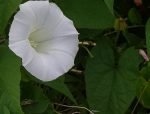 Hedge bindweed is a herbaceous perennial vine that can trail on the ground or cover fences, trees ,and shrubs with its twining stem. It is a member of the morning glory family, Convolvulaceae, that also includes dodder and sweet potato and is native to eastern US, Washington and Oregon. Preferring mesic and moist sites in full to partial sun, hedge bindweed is found in disturbed sites including roadsides, railroad tracks, waster areas, abandoned fields, fence rows, and the edges of woodland and cropland.
Hedge bindweed is a herbaceous perennial vine that can trail on the ground or cover fences, trees ,and shrubs with its twining stem. It is a member of the morning glory family, Convolvulaceae, that also includes dodder and sweet potato and is native to eastern US, Washington and Oregon. Preferring mesic and moist sites in full to partial sun, hedge bindweed is found in disturbed sites including roadsides, railroad tracks, waster areas, abandoned fields, fence rows, and the edges of woodland and cropland.
Description: Growing from extensive rhizomes, the vine is thin, light green to reddish and up to 12′ long. The arrow-shaped leaves that are 2.5-5′ long and squared-off lobes at the base. The trumpet-shaped flowers are 1-3″ across, slightly 5-lobed, and white to pale pink, sometimes striped. They appear from late spring through late summer with each flower opening in the morning until noon and last only one day. Brown to black capsules 1/4″ across follow with 2-4 seeds. Plants spread by rhizomes and seeds.
Control: Hedge bindweed is difficult to control because of its deep root system and the fact that pieces of the rhizome left in the soil will produce new plants so removing an infestation of the weed may take several years. Dig or pull out young shoots getting as much of the root system as possible. Repeat until no more shoots appear. Do the same for older plants. Alternatively, cut down all shoots and plants and cover with a dense mulch such as cardboard or newspaper for at least a growing season. In severe cases glyphosate can be applied being careful not to spray any desirable plants. Manually removing the vines from the other plants and laying them on the ground before spraying may be necessary. Applications of glyphosate are most effective when applied in the evening when the plants are blooming.